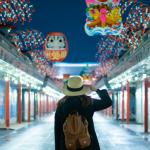Japan’s temples and shrines are iconic symbols. They represent the country’s rich spiritual heritage and cultural identity. These sacred sites provide insights into Japan’s architecture. They show the beauty of ancient craft and the nation’s adaptability through the ages.
Come along on an enlightening journey through some of Japan’s most significant temples and shrines. Explore their historical significance. These sites boast tranquil atmospheres and enduring spiritual practices. These practices infuse these architectural marvels with life.
The Spiritual Heartbeat Of Japan
Spirituality is at the core of Japanese identity. It shapes its art, values, festivals, and architecture. Japan has two main belief systems: Shinto and Buddhism. They have coexisted in harmony for centuries. They shaped sacred spaces that venerate kami (Shinto deities) and Buddhas. This intermingling is embodied beautifully in the design of temples and shrines. For those looking to immerse themselves in this spiritual heritage, booking Japan tours can provide an enriching and seamless experience.
Shinto shrines tend to have simple thatched roofs and raised floors. They also have torii gates. The gates mark a transition from the mundane to the sacred. These gates enshrine kami. They are often built in locations with features like mountains, forests, and seas. These features are considered embodiments of divine spirits.
Buddhist temples display more ornate features like pagodas, elaborate carvings, and zen gardens. They house images of many Buddhas and bodhisattvas. These temples serve as sanctuaries for meditation, rituals, and the study of Buddhist teachings.
This mix of Shinto and Buddhist elements makes Japanese architecture. It honors the country’s two spiritual traditions. The temples and shrines we explore on this journey exemplify this harmonious blend.
Architectural Marvels And Sacred Spaces
Japan’s temples dazzle with their beauty. They also provide serene spaces for spiritual contemplation and practice. Here are some of the most iconic:
Kiyomizu-Dera, Kyoto
It is famed for its wooden stage. It juts out 13 meters above the hillside. This 16th-century Buddhist temple represents Kyoto’s Higashiyama culture. The main hall is built without a single nail and features an enormous verandah supported by 139 pillars.
“The wooden stage, with a panoramic view of nature all around, inspires a feeling of standing in midair, surrounded by the beauty of the four seasons.” – Kiyomizu-dera monk
A temple has stood at this site since 778 AD. Today, Kiyomizu-dera blends seamlessly with the lush forest. The temple captures the harmony of nature and architecture.
Todai-ji, Nara
Todai-ji houses the largest wooden building in the world. The Daibutsuden (Big Buddha Hall) which shelters Japan’s biggest bronze Buddha statue. This 8th-century temple represents the full grandeur of Nara-period architecture. The 153-foot-tall Daibutsuden was built without a wooden framework, showcasing remarkable carpentry skills.
“The Great Buddha’s serene countenance reflects the spirit of Todai-ji immense in size yet sublimely tranquil.” – Todai-ji priest
Todai-ji is surrounded by gardens and inhabited by deer. It takes visitors back in time. It offers glimpses of Japan’s first capital.
Kinkaku-ji, Kyoto
The Golden Pavilion gracefully extends over a mirror pond, glistening brilliantly with its gold leaf coating. It was built in 1397 as a retirement villa for shogun Ashikaga Yoshimitsu. Kinkaku-ji shows Kitayama-period architecture influenced by Zen Buddhism.
“Kinkaku-ji’s golden reflection, set against a lush green landscape, deeply moves those who gaze upon it.” – Kinkaku-ji monk
Although the present Kinkaku-ji pavilion dates from 1955, it faithfully follows the original design. It dates from 1955 but stays faithful to the original design. It’s a breathtaking monument that fuses nature with art.
| Temple | Shrine | |
| Main building | Butsudan or Honden | Honden |
| Roofs | Elaborate, curved eaves | Thatch, straight lines |
| Layout | Geometric courtyards | Meandering pathways |
| Gates | Niomon | Torii |
| Common features | Pagodas, zen gardens | Temizuya, sandō |
Gates To The Gods: Unveiling Shinto Shrines
Beyond Buddhist temples lie Shinto shrines, serene sanctuaries where the kami reside. These are some of the most significant:
Itsukushima Shrine, Miyajima
Itsukushima is one of Japan’s most recognizable landmarks. It has traditional elements like elevated wooden corridors and thatched roofs. The shrine seems to float on water. Built in the 12th century, it is a quintessential example of A-frame construction used in Heian-period shrines.
“In the sea-swept Itsukushima Shrine, we witness the divine spirit of nature.” – Miyajima pilgrim
During high tide, when the shrine appears to float atop the waves, visitors can tangibly feel the mystical union of water and architecture.
Ise Jingu, Ise
Ise Jingu is the spiritual home of the Shinto sun goddess Amaterasu. It is rebuilt every 20 years on adjacent sites. They keep the original 4th-century design and materials. This cyclical renewal spiritually cleanses the shrine.
“Through this act of regeneration, the ancient origins of Ise Jingu are ritually reenacted.” – Chief priest of Ise Jingu
Pilgrims visiting Ise Jingu directly engage with the purest traditions of Japanese architecture and the Shinto values of impermanence.
Fushimi Inari Taisha, Kyoto
The pathways up Inari’s sacred Mount are marked by thousands of vivid orange torii gates. They crisscross through the forest, creating an otherworldly landscape full of mystic energy. Since the 8th century, Fushimi Inari Taisha has been dedicated to Inari, the Shinto kami of rice.
“Walking under row upon row of vermilion torii, one feels immersed in the benevolent power of Inari.” – Head priestess of Fushimi Inari Taisha
These countless gates and votive offerings bear inscriptions of donors’ names. They make a mesmerizing tapestry. It leads devotees through the world of the spirits.
Spiritual Practices And Festivals
Beyond their physical beauty, Japan’s temples and shrines come alive through rituals, ceremonies, and festivals the beating heart of spirituality.
- Sacred pilgrimages along ancient routes like Kumano Kodo and Shikoku’s 88 Temple Circuit allow for self-reflection, immersion in nature, and community bonding.
- New Year celebrations mark a time of renewal and hope. Japanese visit shrines and temples during the first days of January to pray for health and prosperity.
- Matsuri festivals throughout the year, from Hadaka in Okayama to Takayama in Gifu, unite entire communities in the joyous celebration of local deities and culture.
These traditions strengthen connections between people, nature, and the divine. They offer opportunities for spiritual renewal. Through participation, we honor the purpose for which Japan’s sacred architecture was created.
Evolution Of Sacred Architecture
Japan’s temples and shrines cling to their spiritual roots. They have evolved over centuries. They have incorporated new techniques and materials.
- From the Asuka period onward, Japan adopted Chinese-inspired designs. In the Heian period, they built grand, multistoried layouts. This was a time of experimentation and innovation.
- The Meiji Restoration in 1868 led to a backlash against Buddhist structures. Shinto shrines were built in traditional Japanese nagare-zukuri and shinmei-zukuri styles using impermanent materials like wood, thatch, and cypress bark.
- Contemporary architects now face the dilemma of accommodating modern needs while preserving traditional forms. We balance synthetic materials and anti-seismic tech with layouts, spaces, and elements. They are aligned with historical wisdom.
“We must thoughtfully move forward with the times while keeping an eye on the past.” – Renzo Piano, architect of the Modern Art Museum in Kanazawa
Preserving Heritage
Conserving Japan’s old buildings is challenging. It faces urbanization, tourism, and climate hazards. The task needs effort from both the government and the community.
- Formally designating sites as cultural properties and UNESCO World Heritage Sites, like the Historic Monuments of Ancient Nara, bolsters legal protection.
- They monitor and regulate visitor numbers. They erect barriers. They develop tourism policies. These steps lessen harm and prevent decay.
- Non-profit foundations and a growing conservation field safeguard historic buildings through restoration and professional training programs.
- Local volunteers clean and care for sacred grounds as an act of devotion to their community’s heritage.
We value these sites as keepers of Japan’s spirit. This ensures that future generations can experience the timeless wisdom carved in their stones.
Capturing The Essence
Taking photos of the light, nature, and architecture in Japan’s temples and shrines shows their beauty and spirituality to the world.
- Early mornings see sunlight filtering through the mist. Evenings are bathed in golden hour. They showcase these spaces sublimely.
- Frame shots to highlight striking design features such as pagodas, torii gates, and zen gardens.
- Choose vantage points that reveal the majestic rural or forested surroundings.
- Be respectful by obeying photo restrictions, staying on marked paths, and leaving no trace.
Steve McCurry said, “If you wait, people will forget your camera and the soul will drift up into view.”
So, journey patiently and discover the true essence of Japan’s sacred architecture. Let these icons be an inspiration. They are icons of spirituality and ingenuity. They have inspired for centuries. Let them inspire you to reflect on the wonder of this world and your place in it.
Plan Your Pilgrimage
If this glimpse into Japan’s architectural treasures has sparked your interest, it is time to embark on your pilgrimage! Check out these top Japan tour operators to start crafting your custom temple and shrine itinerary:
- Inside Japanese Tours
- Walk Japan
- Andante Travels
- Samurai Tours
- Oku Japan
Let the journey unfold step by step. Discover your spiritual connection with these breathtaking sanctuaries. The mountains, forests, and seas of Japan await.
Conclusion
Visiting Japan’s temples and shrines offers a portal into the nation’s spiritual heart. They preserve and bring to life the icons of classic architecture. While visually magnificent, the castles also boast a deep heritage. But, they also have a deep heritage. It comes from the mix of Shinto and Buddhist traditions and the rituals connecting past and present. Conservation efforts ensure the heritage’s longevity. Yet, they are adapting to the demands of the modern world. Yet spirituality remains the core of the stillness within that the structures create and amplify. We share centuries of spiritual nourishment. We do this by photographing, visiting, or appreciating these sacred sites.
Frequently Asked Questions
What is the main difference between a temple and a shrine?
Temples are part of Buddhism and house Buddhas. Shrines are linked to Shinto and enshrine kami. Temple architecture has more ornate details while shrines use simpler, natural elements.
What etiquette should you follow when visiting temples and shrines?
Be respectful, dress modestly, and refrain from loud chatter. Follow any specific instructions given by signs or guides at each site. Photography may be restricted in certain areas.
How do the seasons enrich visits to these sacred sites?
The foliage and weather change the look and feel of the landscapes. They surround temples and shrines throughout the year. Seasonal festivals also provide different cultural experiences.







